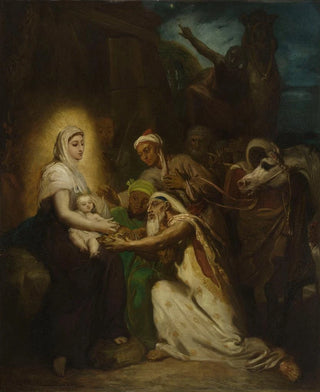Art print | The Adoration of the Magi - Théodore Chassériau


View from behind

Frame (optional)
The artwork "L'Adoration des Mages" by Théodore Chassériau, painted in the 19th century, stands as a true ode to the magnificence of the biblical scene. This painting, which highlights the meeting of the Magi with the Infant Jesus, transcends a simple narrative to offer a striking visual experience. The soft light bathing the figures, the expressions filled with devotion, and the play of warm, rich colors invite the viewer to immerse themselves in an atmosphere that is both sacred and contemplative. Gazing upon this piece, one is transported to a universe where the divine and the human meet, revealing both the grandeur and vulnerability of Christ's birth. Chassériau, through his unique approach, manages to capture the very essence of this spiritual encounter.
Style and uniqueness of the work
Chassériau's style is distinguished by a subtle blend of classicism and romanticism, which gives "L'Adoration des Mages" a rare emotional depth. The composition is carefully orchestrated, with figures arranged to guide the eye toward the Infant Jesus, the central figure of the scene. The drapery of the garments, rendered with remarkable precision, almost feels tangible, adding a tactile dimension to the piece. The faces, meanwhile, express a range of emotions from wonder to adoration, each character meticulously characterized. Chassériau uses light not only to create volumes but also to emphasize the sacred nature of the moment. This masterful use of light and color makes this work an emblematic example of his talent, while also demonstrating his commitment to a faithful and respectful representation of religious themes.
The artist and his influence
Théodore Chassériau, born in 1819, is often regarded as one of the most influential painters of his time, although his work has been somewhat overshadowed by that of his contemporaries. His artistic journey, marked by training with great masters, allowed him to develop a distinctive style that combines academic rigor with romantic sensitivity.

Matte finish

View from behind

Frame (optional)
The artwork "L'Adoration des Mages" by Théodore Chassériau, painted in the 19th century, stands as a true ode to the magnificence of the biblical scene. This painting, which highlights the meeting of the Magi with the Infant Jesus, transcends a simple narrative to offer a striking visual experience. The soft light bathing the figures, the expressions filled with devotion, and the play of warm, rich colors invite the viewer to immerse themselves in an atmosphere that is both sacred and contemplative. Gazing upon this piece, one is transported to a universe where the divine and the human meet, revealing both the grandeur and vulnerability of Christ's birth. Chassériau, through his unique approach, manages to capture the very essence of this spiritual encounter.
Style and uniqueness of the work
Chassériau's style is distinguished by a subtle blend of classicism and romanticism, which gives "L'Adoration des Mages" a rare emotional depth. The composition is carefully orchestrated, with figures arranged to guide the eye toward the Infant Jesus, the central figure of the scene. The drapery of the garments, rendered with remarkable precision, almost feels tangible, adding a tactile dimension to the piece. The faces, meanwhile, express a range of emotions from wonder to adoration, each character meticulously characterized. Chassériau uses light not only to create volumes but also to emphasize the sacred nature of the moment. This masterful use of light and color makes this work an emblematic example of his talent, while also demonstrating his commitment to a faithful and respectful representation of religious themes.
The artist and his influence
Théodore Chassériau, born in 1819, is often regarded as one of the most influential painters of his time, although his work has been somewhat overshadowed by that of his contemporaries. His artistic journey, marked by training with great masters, allowed him to develop a distinctive style that combines academic rigor with romantic sensitivity.






